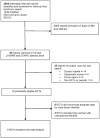Double versus single homologous intrauterine insemination for male factor infertility: a systematic review and meta-analysis
- PMID: 23708457
- PMCID: PMC3739246
- DOI: 10.1038/aja.2013.4
Double versus single homologous intrauterine insemination for male factor infertility: a systematic review and meta-analysis
Abstract
Male factor infertility affects 30%-50% of infertile couples worldwide, and there is an increasing interest in the optimal management of these patients. In studies comparing double and single intrauterine insemination (IUI), a trend towards higher pregnancy rates in couples with male factor infertility was observed. Therefore, we set out to perform a meta-analysis to examine the superiority of double versus single IUI with the male partner's sperm in couples with male factor infertility. An odds ratio (OR) of 95% confidence intervals (CIs) was calculated for the pregnancy rate. Outcomes were analysed by using the Mantel-Haesel or DerSimonian-Laird model according to the heterogeneity of the results. Overall, five trials involving 1125 IUI cycles were included in the meta-analysis. There was a two-fold increase in pregnancies after a cycle with a double IUI compared with a cycle with a single IUI (OR: 2.0; 95% CI: 1.07-3.75; P<0.03). Nevertheless, this result was mainly attributed to the presence of a large trial that weighted as almost 50% in the overall analysis. Sensitivity analysis, excluding this large trial, revealed only a trend towards higher pregnancy rates among double IUI cycles (OR: 1.58; 95% CI: 0.59-4.21), but without statistical significance (P=0.20). Our systematic review highlights that the available evidence regarding the use of double IUI in couples with male factor infertility is fragmentary and weak. Although there may be a trend towards higher pregnancy rates when the number of IUIs per cycle is increased, further large and well-designed randomized trials are needed to provide solid evidence to guide current clinical practice.
Figures
Similar articles
-
In vitro fertilisation for unexplained subfertility.Cochrane Database Syst Rev. 2005 Apr 18;(2):CD003357. doi: 10.1002/14651858.CD003357.pub2. Cochrane Database Syst Rev. 2005. Update in: Cochrane Database Syst Rev. 2012 Apr 18;(4):CD003357. doi: 10.1002/14651858.CD003357.pub3. PMID: 15846658 Updated.
-
Intra-uterine insemination for unexplained subfertility.Cochrane Database Syst Rev. 2016 Feb 19;2:CD001838. doi: 10.1002/14651858.CD001838.pub5. Cochrane Database Syst Rev. 2016. Update in: Cochrane Database Syst Rev. 2020 Mar 3;3:CD001838. doi: 10.1002/14651858.CD001838.pub6. PMID: 26892070 Updated.
-
In vitro fertilisation for unexplained subfertility.Cochrane Database Syst Rev. 2002;(2):CD003357. doi: 10.1002/14651858.CD003357. Cochrane Database Syst Rev. 2002. Update in: Cochrane Database Syst Rev. 2005 Apr 18;(2):CD003357. doi: 10.1002/14651858.CD003357.pub2. PMID: 12076476 Updated.
-
Interventions for unexplained infertility: a systematic review and network meta-analysis.Cochrane Database Syst Rev. 2019 Sep 5;9(9):CD012692. doi: 10.1002/14651858.CD012692.pub2. Cochrane Database Syst Rev. 2019. PMID: 31486548 Free PMC article.
-
Intra-uterine insemination for male subfertility.Cochrane Database Syst Rev. 2007 Oct 17;(4):CD000360. doi: 10.1002/14651858.CD000360.pub4. Cochrane Database Syst Rev. 2007. Update in: Cochrane Database Syst Rev. 2016 Feb 26;2:CD000360. doi: 10.1002/14651858.CD000360.pub5. PMID: 17943739 Updated.
Cited by
-
Double intrauterine insemination (IUI) of no benefit over single IUI among lesbian and single women seeking to conceive.J Assist Reprod Genet. 2019 Oct;36(10):2095-2101. doi: 10.1007/s10815-019-01561-3. Epub 2019 Aug 13. J Assist Reprod Genet. 2019. PMID: 31410635 Free PMC article.
-
Single-donor and double-donor sperm intrauterine insemination cycles: does double intrauterine insemination increase clinical pregnancy rates?Fertil Steril. 2014 Sep;102(3):739-43. doi: 10.1016/j.fertnstert.2014.05.018. Epub 2014 Jun 14. Fertil Steril. 2014. PMID: 24934490 Free PMC article.
-
Double versus single intrauterine insemination (IUI) in stimulated cycles for subfertile couples.Cochrane Database Syst Rev. 2021 Jul 14;7(7):CD003854. doi: 10.1002/14651858.CD003854.pub2. Cochrane Database Syst Rev. 2021. PMID: 34260059 Free PMC article.
-
Do Serum Vitamin D Levels Have Any Effect on Intrauterine Insemination Success?Int J Fertil Steril. 2018 Jul;12(2):164-168. doi: 10.22074/ijfs.2018.5256. Epub 2018 Mar 18. Int J Fertil Steril. 2018. PMID: 29707935 Free PMC article.
References
-
- Lipshultz LI, Howards SS, Niederberger CS.Infertility in the Male. 4th ed Cambridge; Cambridge University Press; 2009. ; pxi, 677[8] p. of plates.
-
- Willets AE, Corbo JM, Brown JN.Clomiphene for the treatment of male infertility. Reprod Scie-pub ahead of print November 2012; doi:10.1177/1933719112466304. - PubMed
-
- Collins JA, Burrows EA, Wilan AR. The prognosis for live birth among untreated infertile couples. Fertil Steril. 1995;64:22–8. - PubMed
-
- Wright VC, Chang J, Jeng G, Macaluso M. Assisted reproductive technology surveillance—United States, 2005. MMWR Surveill Summ. 2008;57:1–23. - PubMed
Publication types
MeSH terms
LinkOut - more resources
Full Text Sources
Other Literature Sources
Medical




